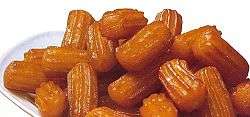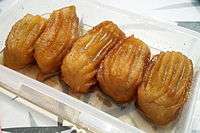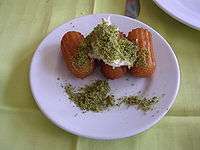Tulumba
 | |
| Type | Dessert |
|---|---|
| Place of origin | Ottoman Empire |
| Region or state | Countries of the former Ottoman Empire, Balkans, Middle East, Caucasus |
| Main ingredients | Flour, butter, salt, water, egg, syrup |
|
| |
Tulumba (Turkish: tulumba tatlısı, Greek: τουλούμπα, Cypriot Turkish bombacık; Cypriot Greek πόμπα (pomba); Armenian: պոմպ (pomp) or թուլումբա (tulumba), Albanian tullumba, Bosnian tulumba, Bulgarian, Macedonian, Serbian: тулумба) is a popular dessert found in the cuisines of the former Ottoman Empire. It is a fried batter soaked in syrup, similar to jalebis and churros.
The sweet is also found in Iranian cuisine as bamiyeh, and in Egypt, as balah ash-sham (Arabic: بلح الشام), while it is called in Iraq as Datli (Arabic: داطلي). In the Arab world, it is called asabe Zainab (Zainab's fingers), and it is customarily consumed during Ramadan.
It is made from unleavened dough lump (about 3 cm long) given a small ovoid shape with ridges along it using an 'icing' bag with a special nozzle. It is first deep-fried to golden colour and then sugar-sweet syrup poured over it when still hot. It is eaten cold.
Name
Tulumba literally means 'pump' in Turkish, as does the Cypriot πόμπα.
Gallery
-
Zulbiā and bāmieh in Iran
-
Tolumba
-

Тулумби
-

Tulumba with kaymak and pistachio
-
Tulumba cross-section (front)
See also
External links
 Media related to Tulumba at Wikimedia Commons
Media related to Tulumba at Wikimedia Commons